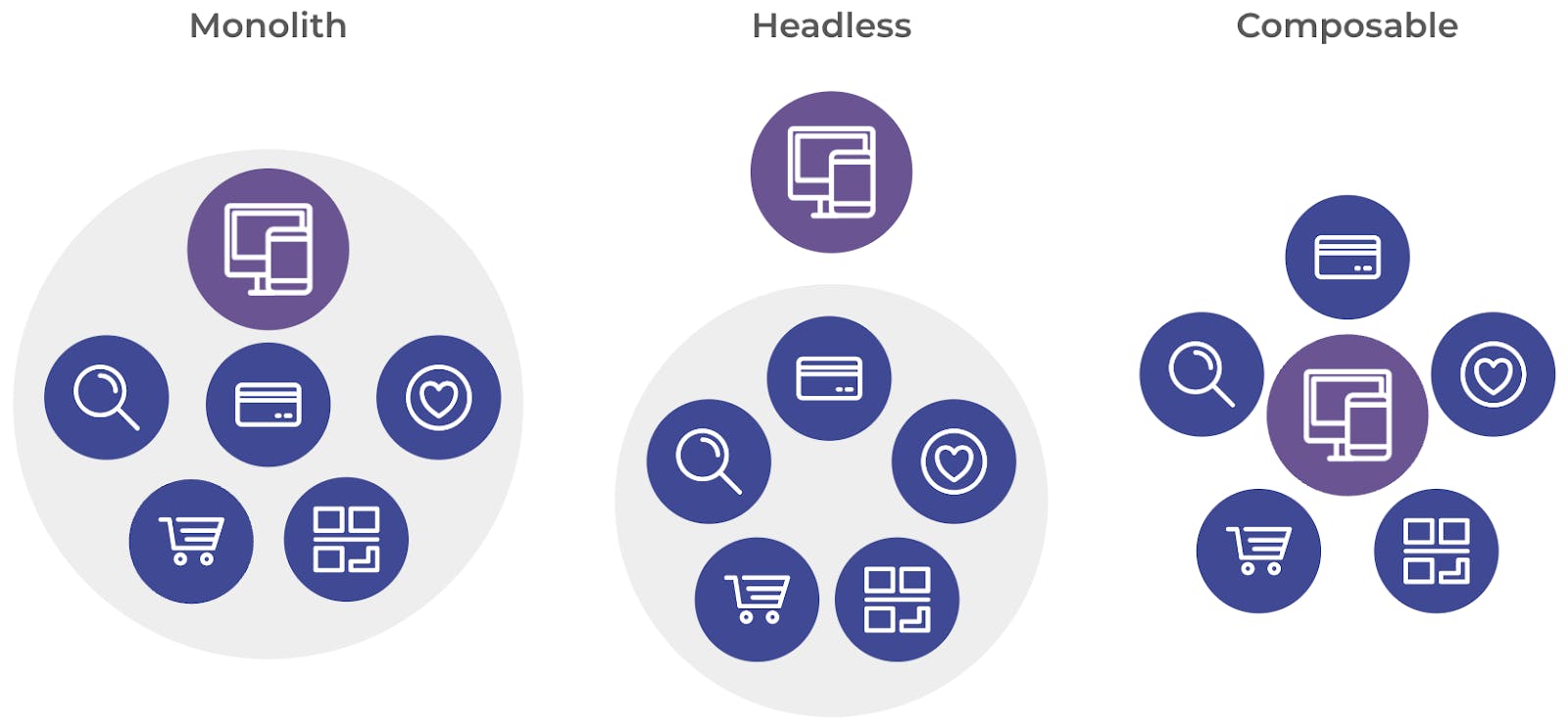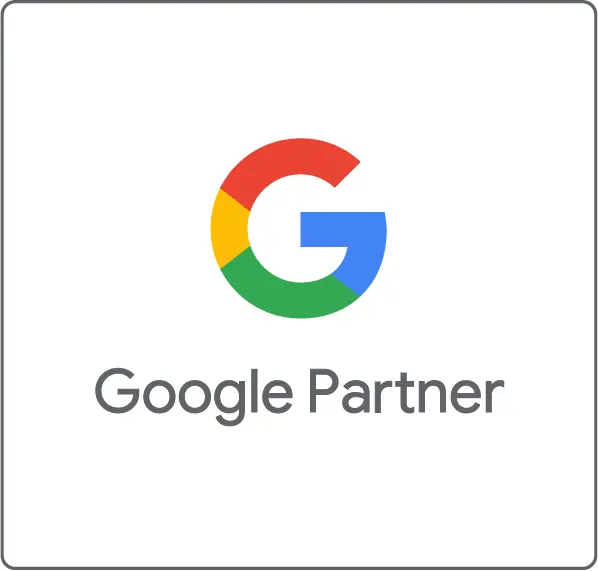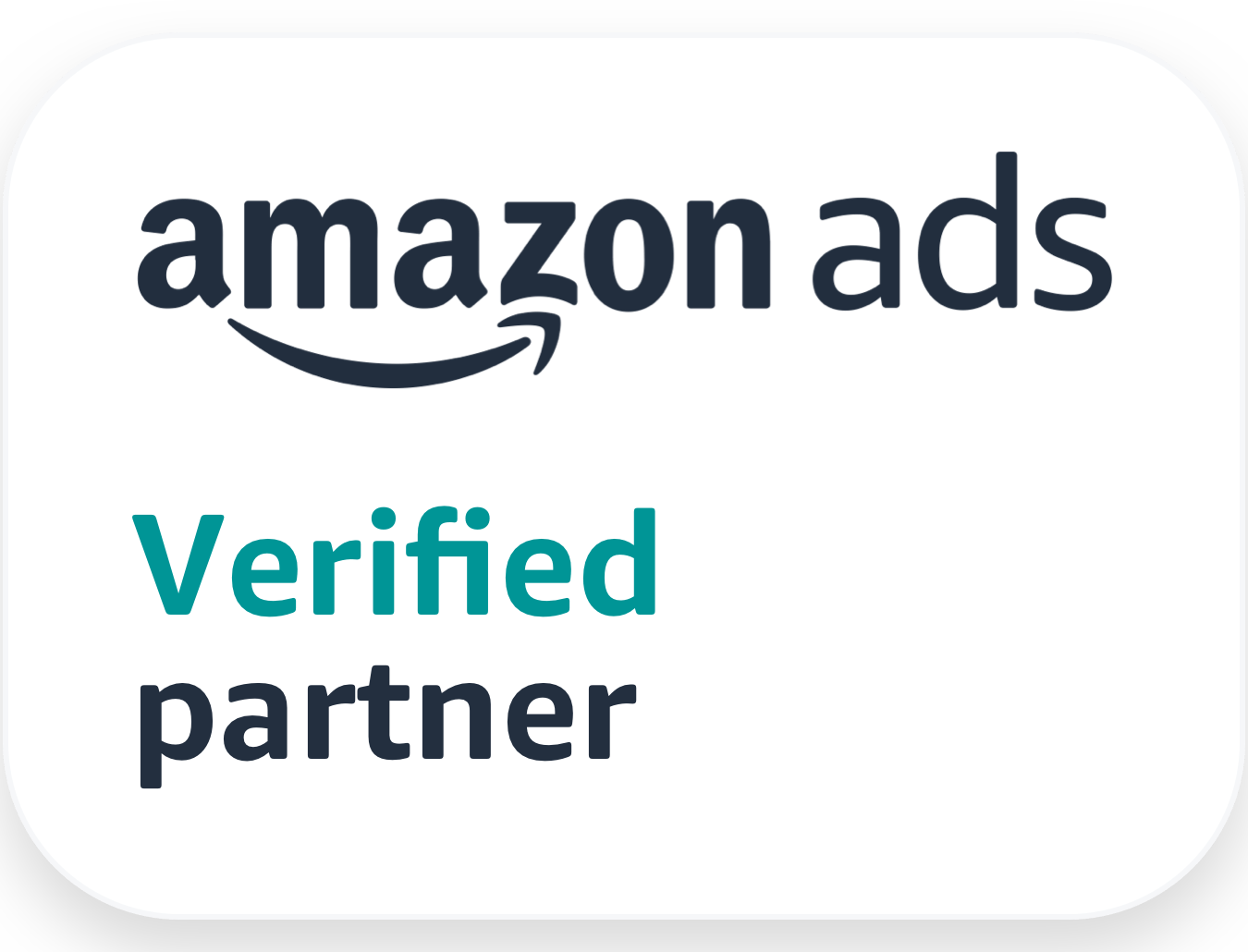eCommerce Replatforming Guide

Get to know four of the most common strategies for improving your ecommerce infrastructure and taking your business to the next level.
Rising costs, export challenges and consumer uncertainty have all had an impact on trading as we move into 2024. We’re facing what is shaping up to be a challenging year for many businesses.
But despite the challenges we’re all facing, standing still is rarely a sensible option in the highly competitive world of ecommerce.
With that in mind, we've taken an unbiased look at a few strategies available to you, when looking at how to move your ecommerce platform and performance forward in 2024.
Who is this guide for?
This guide is a summary of four common routes we find ourselves proposing regularly to clients.
Those clients tend to be established SME and Mid-Market ecommerce businesses on a traditional monolithic platform - be that a Shopify, Bigcommerce, Magento/Adobe Commerce, Woocommerce or custom build. Generally they’ve reached the limit of their current platform’s capabilities, they’re experiencing pain with their existing ecommerce setup and need help to move forward.
The topic is naturally complex and the key message we want everyone to take home is that the best route for you depends entirely on your business and your specific requirements.
But we hope that this guide will offer a pragmatic, thought-provoking and unbiased overview of a few of the key options.
Four common improvement strategies for 2024
We’ll explore each of these options in more detail to help you better understand where you could take your ecommerce business in 2024.
- Stick and improve Why move when you can avoid the risks and improve your existing ecommerce site on the same platform?
- Move to a monolith Take the simplest route to meeting your new requirements by moving to another platform with a simple monolithic architecture.
- Make it Headless Chop the head off your existing monolith to take your first steps into the future of ecommerce with a modern Headless architecture.
- Go fully Composable Embrace the future and jump right in, with a fully composable architecture, but be aware of the pros and cons.
All about ecommerce platform architecture
Before we get into it, it’s important to understand some of the terminology we’ll be using. Architecture is one key area of confusion - and has seen some of the biggest developments in recent years - with three main configurations becoming prevalent.
Monolith ecommerce architecture
Traditional monolith where frontend and backend functionality is all contained within the same off-the-shelf platform. This is likely to be the basic architecture you inherit with any of the popular ecommerce platforms - Shopify, BigCommerce, Adobe Commerce / Magento 2.
Headless ecommerce architecture
Headless is an approach that starts to deliver more flexibility, by separating the frontend presentation layer from the backend ecommerce functionality. This can allow you to enhance the frontend experience with an all-in-one frontend solution or bespoke Progressive Web App (PWA).
While it can add complexity, it opens up a world of new opportunities to craft the experience you want. And with the frontend and backend decoupled, you can make many quicker and easier updates to each one, without impacting the other.
Composable ecommerce architecture
Finally, Composable takes things to the next level, using flexible APIs to link together your own bespoke stack of technologies. With this approach you can achieve even more flexibility and futureproofing than Headless, with the ability to chop and change individual elements to get just the right mix.
While things are getting progressively more plug-and-play, the realities of a Composable approach can mean you still require a fair amount of development support.
Despite all the benefits, this approach may still be a challenge to cater for unique requirements in the way that a more natively customisable monolithic platform could.

Key considerations
Before you embark on any programme of ecommerce infrastructure improvement or replatforming, there are three key considerations which are essential to get your head around. We've written about length in our guide to Writing a Good Ecommerce Brief [with free RFP template].
Your requirements
The most important consideration. You must have a clear idea of what you need
We like to think of ourselves as platform agnostic - we don’t buy into the idea of one platform being better than another in an absolute sense.
The correct route for you and your business is always unique to you and your situation. But we do frequently see businesses falling into a trap of ‘platform preference’ or succumbing to a biassed sales agenda.
It’s important that you have a clear understanding of your requirements before you get started. Start with your requirements and select a solution to match - not the other way around.
The correct route for you and your business is always unique to you and your situation.
”Ask yourself these questions:
- What exactly are your current pain points and desired outcomes?
- If you plan to change platforms, what specific functionality does your current platform have that you can’t live without?
- Which functional elements are essential and which are desired / nice-to-have?
- Pay particular care to any level of customisation you have in place or any non-standard functionality.
Above all, get it written down. The more that you can capture, the better, and there is often a lot of information.
Don't feel overwhelmed though, our Discovery service is designed to help businesses like yours make sure they're armed with all the information they need to build the right website the first time around.
Total Cost of Ownership (TCO)
A hugely important concept. The cost of development plus ongoing & maintenance costs.
Some platforms are seen as being cheaper than others to set up and to run. Some platforms are seen to require more development than others. But rarely is the picture all that simple and businesses often fail to take TCO into account when replatforming their ecommerce website.
Poor scoping or planning and the failure to identify and account for hidden costs can have serious expenditure implications for the project and in the longer term. That’s why it’s best to be as clear as possible on the total cost of platform ownership, upkeep and management before you embark on a project.
Wherever possible, try to consider the future and where your business hopes to be. Ensure that platform choices made today won’t restrict you or increase costs later. But equally, be realistic about just how powerful you need your platform to be right now.
Risk
Don’t underestimate the cost of things going wrong. SEO & data migration need careful consideration.
No ecommerce improvement project comes entirely free of risk, but those risks can be mitigated with careful planning.
Invariably, the benefits realised by moving forward vastly outweigh the risks, but it’s important to go into these things with your eyes open.
The biggest risks to most improvement or replatforming projects tend to be in terms of project cost, SEO & data migration. Prepare for the risks and you’ll vastly reduce the chances of them becoming reality.
As we’ve mentioned already - preparation, scoping and planning will minimise risks to project budgets and timelines.
No ecommerce replatforming project comes entirely free of risk.
”Beware of pushing ahead with poorly scoped or flimsily-estimated projects. While you may desire accurate estimates from multiple suppliers, the reality is that it’s virtually impossible to fully cost a project until after a thorough discovery phase.
One of the most frequently overlooked areas in replatforming projects is SEO, and it can be financially catastrophic for established businesses.
If your selected partner can’t provide detail about their approach and successful case studies, then seek external support.
Ask yourself seriously if you need to make changes to things like URL structure and only do so if unequivocally beneficial.
Finally, consider risks to your customer and product data, and the ways in which you work with it. Data formatting and migration issues can lead to increased costs, data loss or privacy issues.
Understanding the data limitations of the platform you’re moving to and having a solid data migration strategy will help.
Route 1: Stick & Improve
What does it mean? Continuous improvement. Enhance your site on your current platform.
Why would I do it? Often the lowest-cost and lowest-risk option, but not exclusively.
Pros? Avoids the risks & headaches of platform migration.
Cons? Could leave you limited in the long run. Not always the lowest-cost option.
improving your underlying ecommerce platform enhances the performance of virtually every other channel, so it’s rarely a bad investment.
”The first and most straightforward route to ecommerce replatforming is to stick with your existing platform and continuously improve it. It’s often the lowest cost option and can significantly reduce the risk of a replatforming.
Chances are, you’re unlikely to have fully realised all of the potential improvements you could make to your site while keeping it where it is.
Look in-depth at user experience, speed, hosting, new developments in terms of apps or integrations - you may be able to unblock some of the issues that are causing you headaches and impeding your growth.
Work with your development partner to put in place a proactive roadmap of continual improvement. At the end of the day, improving your underlying ecommerce platform enhances the performance of virtually every other channel, so it’s rarely a bad investment.
Will the low-cost option stand you in good stead later?
Let’s say you’re on a basic Shopify or some similar SAAS monolith, you might choose to take the lowest-risk option and try to maximise the performance of your existing site.
There’s a huge amount you can do creatively with apps and theme customisation, but ultimately, you might only be putting a sticky plaster on issues which will come back to haunt you if you need increased flexibility or customisation down the line.
It’s important to consider where you want to be in three to five years.
Sticking where you are isn’t always the cheapest option
If you’re on Magento / Adobe Commerce Open Source, you’re probably acutely aware of the ongoing costs you experience in terms of site maintenance.
While the platform is incredibly powerful and almost infinitely customisable, it could be that you’ll never realise enough of a benefit from that increased customisablility in order to offset the increased cost of ownership.
In this situation, sticking with your current platform and looking to improve it could end up more costly in the long run.
If you don’t have a lot in the way of customisation or custom requirements, migrating to a SAAS platform could actually end up costing less than a major Magento update.
This does, however, very much depend on your requirements and the functionality that you can and can’t live without, so don’t take the decision lightly. As always, our Discovery services can help you figure out the right option before you commit to development investments.
Route 2: Move to a Monolith
What does it mean? Choose a simple monolith that’s better suited to your needs.
Why would I do it? Depends on your circumstances. You may want more power or lower costs.
Pros? Simpler and with lower costs than some other options.
Cons? Higher risk and (most likely) cost than sticking on your existing platform.
If you’re clear about your requirements and sure your current platform can’t match your long term goals, the most straightforward move is to another monolith.
Chances are it’ll be relatively low cost versus other options and while any sort of replatforming increases risk, the benefits can easily outweigh those risks.
Always be aware of the risks
It’s important to consider the restrictions of any new platform in terms of data and SEO in particular.
Consider product data, customer and order history data, reviews, login credentials and more. You need to understand what you can migrate and the format that’s required.
And from an SEO perspective, each platform will have a set of structural characteristics which can mean you need to create a huge amount of change. You’ll be forcing search engines to update the way they understand your website which can negatively impact your hard-fought rankings.
Both of these key risks can be managed, which is why it’s so critically important to choose the right development partner. Whoever you choose, be sure to grill them on their approach to these challenges in particular.
Choosing a monolith over a more modern architecture
Your budget, requirements and future plans will always influence whether you choose to move to another monolith over a more advanced headless or composable solution.
It’s important to remember that a lot of businesses still realise a lot of success with traditional monolithic platforms - so don’t feel undue pressure to make the leap to Headless or Composable now.
One common reason we get cited is site speed. Traditionally, going with a Headless architecture would make it easier to achieve faster page speeds.
However, modern monolithic platforms have made leaps and bounds in recent times in this area, with newer technologies and frameworks delivering big performance benefits.
The days of Headless or Composable Solutions being a ‘must’ are probably still some way away. Most platforms are making it increasingly easier and cheaper to introduce elements of composability over time, so choosing a well-supported and forward-thinking monolithic platform now is likely to lead to easier adoption of the best bits of Headless & Composable later.
If you’re on a platform like Shopify…
You might find limitations in terms of customisation or integration capability. You may want more power and flexibility to do what you want. While the gap has certainly closed of late, moving to a platform like a Magento/Adobe Commerce can be worth the increased cost and complexity.
If you’re on Magento…
It might never make financial sense. If you don’t need a lot of customisation then you could save significantly over the long term with a SAAS platform like Shopify.
However, if your website relies on customised functionality, you’ll need to decide whether you can forfeit that functionality.
Developing similar customisations in SAAS platforms can end up costing as much as sticking with Magento, or more. This is where it’s more important than ever to fully discover your requirements and consider Total Cost of Ownership (TCO).
Route 3: Make it Headless
What does it mean? Take your existing platform and replace the frontend.
Why would I do it? You need more flexibility. You want to introduce more brands or storefronts.
Pros? Keep your data where it is, maintain your backend integrations.
Cons? Complexity not for everyone. Some limitations vs fully composable.

A headless ecommerce solution is rapidly becoming the norm for businesses of the requisite size and scale.
Platforms are increasingly opening up and standardising their APIs, and with more and more off-the-shelf frontend solutions in the market, it’s becoming an increasingly popular option.
Open up benefits while reducing risk
If you’re not at the stage where a fully API-first or composable-native platform is for you, then you could take your existing monolithic setup headless to achieve many of the benefits.
By replacing the existing frontend with a Progressive Web App or off-the-shelf frontend solution, you can increase performance and deliver an enhanced experience for your customers without a full migration.
The beauty of this approach for many clients is that you maintain all of your data and backend integrations, which can be very costly and problematic to migrate to a new platform.
Digital Six an early-adopter of this technique and made it work for a number of bigger SME or mid-market businesses. Read about how we built a streamlined headless architecture and a suite of lightning-fast progressive web apps for Ian Macleod Distillers.
Craft better, faster, more flexible experiences
Quite often the traditional monolithic platforms will have quite limited power and flexibility when it comes to crafting the sort of enhanced customer experience that’s going to set your business apart.
A Headless frontend can combine the variety of specialist tools and technologies that you need to create beautiful experiences.
By using something like a completely custom frontend (built on recognised frameworks) it's often easier to add interactivity, animations and effects that can increase user engagement.
A Headless architecture allows us to introduce modern loading techniques like skeleton screens and loading animations that are proven to help keep users engaged and provide a more polished experience.
A Progressive Web App approach will also deliver speed, performance and functionality benefits over a traditional monolithic frontend - opening up the opportunity to leverage app-like features like push notifications.
What’s good for users is generally good for search engines too, so with the right configuration, a PWA might help to deliver huge SEO gains.
🤔 Never heard of a PWA? Check out our guide to Progressive Web Apps for ecommerce, or take a look at some examples.
The complexity isn’t for everyone
While the benefits of a Headless architecture and PWA technology can be massive, it’s important to be realistic about your business, your requirements and the skill level of your development partner.
A more complex solution will usually require more technical support and can lead to a higher Total Cost of Ownership.
The speed of a PWA can count in your favour from an SEO and UX perspective, but the technical side of how these sites behave is very different. You must select a partner who understands the nuance and has the specialist skills to manage it.
If you’re used to easily being able to plug apps into the frontend of your ecommerce platform with little to no development support, and that’s something you want to retain, then a Headless approach may not be for you.
Route 4: Go fully Composable
What does it mean? Link together a tailored tech stack using flexible API connections.
Why would I do it? You’ve got complex requirements, big budgets and a desire to future-proof.
Pros? APIs open up a world of opportunity and future-proof flexibility.
Cons? Can be costly and restrictive versus customisation of a monolith.
If you’re not reliant on a complex web of existing backend integrations, then the move to a fully composable architecture could make more sense.
This approach gives businesses the freedom to choose the exact mix of components that you need to deliver the best possible outcome for your business and customers.

Make a break from tradition
You can choose to leverage as much or as little of the functionality of a traditional ecommerce platform like Shopify or Bigcommerce as you like. Or you can choose to shun the traditional ecommerce platform altogether in favour of a fully API-first platform like Commercetools or Elasticpath.
These platforms have been designed with Composable in mind from the ground up, and they can be much more advanced than the traditional ecommerce platforms who are playing catch-up. The drawback being that they can also be much more expensive.
The freedom to choose and keep choosing
The beauty of a composable is that once you’ve settled on the exact mix of tools and technologies you want, you’re not married to them in the way that you once were.
It’s easier than ever to chop and change between elements, and to access new channels and opportunities as they arise.
Composable doesn't always mean customisable
”Composable versus customisable
It’s important to make the distinction between a composable approach and customisation. A composable architecture relies on composing a stack of pre-existing solutions which best meet your requirements.
If you have very unique requirements, you may find it’s not easy to find a stack which exactly suits your needs.
You may still need to customise functionality or you may find the need that it’s not altogether that easy to hang together the stack that you want.
Therefore you can end up with higher costs, both initially and in the longer run, than if you had chosen a more customisable monolithic approach, or hybrid Headless architecture.
Is it right for you right now?
There’s no clear answer, unfortunately. Composable can be hugely powerful, but really depends on the nuances of your requirements. While this is the future, it’s perhaps not fully realised just yet, or not at a level that makes it accessible to all.
APIs are becoming more standardised, and some connectors are coming onto the market which make it easier for end users to compose solutions, but you’re likely still to need significant development support and may also still need a fair bit of customisation or middleware solutions to make things work.
Some of the common SAAS platforms claim to be more complete in their vision than they actually are, and the API-native platforms can be pricey. It makes it more important than ever to have a proper understanding of…
- Your business requirements
- The true capabilities of the platforms you’re considering, and…
- The Total Cost of Ownership when project and ongoing costs are considered
Our Discovery services can help you figure out the right option before you commit to development investments. If you'd like to give it a crack yourself, you might find our guide to Writing a Good eCommerce Brief helpful.
The most important thing
Whether you choose to stick and improve or replatform - be that to a Monolithic, Headless or Composable setup - each has its own risks and benefits. The key thing is to understand your requirements clearly.
Think about things holistically and consider the Total Cost of Ownership. Above all, don’t be blinkered - seek expert help and explore all of the options before you make a move.
We’ve been innovating at the forefront of ecommerce for over 20 years, since 1999 in fact.
You can trust our expertise and platform neutrality to help you navigate to the best solution for you and your business. Get in touch for a free no-obligation chat.
Some useful resources
Digital Six's guide to Writing a Good eCommerce Brief [with free RFP template]
Headless ecommerce case study for Edinburgh Gin's website
Our guide to Progressive Web Apps for ecommerce
Some examples of PWAs for ecommerce
Our related ecommerce services
Learn more about our individual ecommerce services on these pages:






